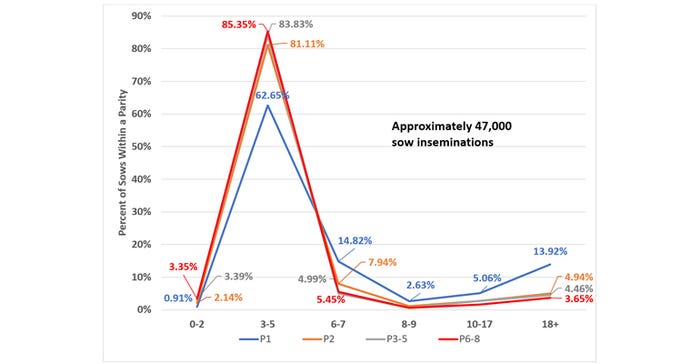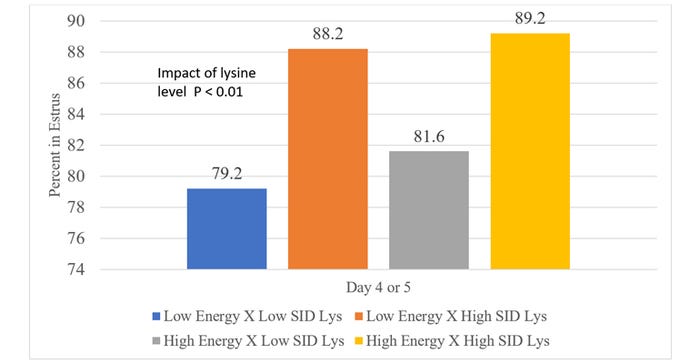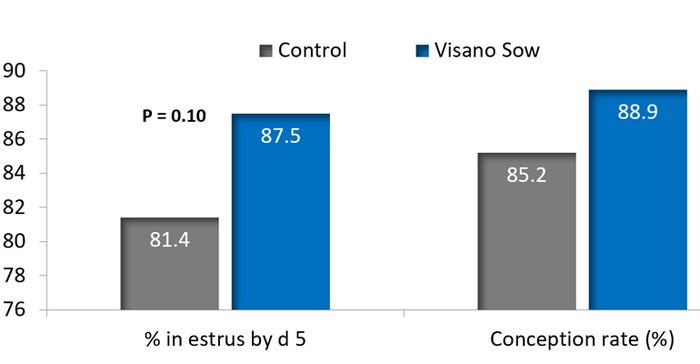Part 2 of 3: Measuring and managing sow reproductive fitness.
Gilt development, lactation intake, disease, management SOPs and nutrition are all significant influencers of WTFSD.
July 1, 2020

Sponsored Content
By Joel Spencer, director of Customer Innovation at United Animal Health
Evaluating the weaning to first service interval (WTFSI) and looking for ways to shorten this nonproductive period in sows is not new. However, a delay of just three days can have a huge impact on farrowing rate (8-10 point reduction) and subsequent total born (1 less pig). We detailed this significant impact in a previous article published here a month ago. Since that publication, individuals have reached out to not only better understand how to improve the wean to first service distribution (WTFSD) in their system, but also to understand how they can use this metric as a measurement to evaluate the efficacy or impact of new technologies and procedures. If we can measure 1) which sows are getting bred past day 5 postweaning, and 2) what efforts influence this percentage of sows, then we can truly manage sows toward the reproductive fitness that drives optimal profitability.
Previously, we shared the WTSFD of approximately 47,000 sows that were weaned and bred in a commercial system. Sows bred on day seven post weaning had a pig less in total born when compared to those bred on day 4. In Figure 1 below, we have further broken that information out by parity. While parity 1 and 2 sows have the greatest opportunity for improvement, there are still opportunities to improve older parities. A general metric of the number of sows bred by seven days would not provide this detail nor reveal this opportunity.
So what factors cause sows to be bred after day 5? Heat checking and breeding procedures can no doubt impact the WTFSI, and semen age can have an impact on farrowing rate and total born when sows are bred past day 5. But there are many other influencers before weaning that can have a very significant impact. Gilt development, lactation intake, disease, management SOP’s and nutrition are all significant influencers. This was displayed very well at multiple professional meetings across multiple disciplines this year. At the Midwest ASAS meetings in March 2020, it was reported that higher lysine levels (1.30% vs. 1.15% SID lysine) improved the percentage of parity one sows bred on day 4 or 5 by nine percentage points (Fig. 2). At the American Association of Swine Veterinarians (AASV) meeting in March 2020, Dr. Terri Specht shared how tracking the percentage of sows bred by day 5 provided an early warning before a disease break at a sow unit. The message is quite simple. What is disrupting sow feed intake, nutrient uptake, or compromising the health status of sows? If sows are coming into lactation over conditioned and therefore have a reduced lactation intake, you will impact the percent bred by day 5. Acute disease that may not be diagnosed yet? Yes, that will have an impact. QC in diet formulation, feeder cleanout, feed outages, mycotoxins, and getting sows up multiple times per day to eat all have an impact. But the key is to establish a sensitive metric as a tool to monitor reproductive fitness that can prompt you to dig deeper and take corrective actions. Percent bred by day 5 provides that lead indicator.
Percent of sows bred by day 5 can also be used to measure if changes are positively impacting reproductive fitness. New SOP’s, feeders, diet formulation, or labor should improve reproductive efficiency, but evaluations over time can be challenging in a sow unit and may not provide clear answers or direction. At United Animal Health, we have started utilizing the bred by day 5 metric to measure the efficacy of nutritional changes to sow diets. In 2018, research was presented at the Midwest ASAS meetings that displayed how a Bacillus-based feed additive could improve sow intake and reduce sow body weight loss in lactation. These significant improvements drove an improvement in the percent of sows bred by day 5 (Fig. 3). This sensitive metric can help us see what is having an impact and bringing value.
Within a week post weaning, supervisors can visit with farrowing house personnel regarding what was done that may have impacted the percent bred by day 5. If we want sows bred by day 5, we need to measure it. If we measure it, we can manage what changes we should implement at our sow unit.

Figure 1. Impact of parity on wean to first service distribution in a commercial production system.

Figure 2. Impact of metabolizable energy (3190 vs 3334 kcal/kg) or dietary lysine level (1.15% vs 1.3 SID lysine) on WTFS distribution of parity one sows. Approximately 170 sows/treatment in a side by side trial conducted at United Animal Health. McCormick, K.A et al, 2020. Midwest Animal Science Meetings, Omaha, NE.

Figure 3. Impact of a direct fed microbial (Visano sow) on the percentage of sows bred by day 5 and conception rate. Approximately 160 sows/treatment in a side by side trial conducted at United Animal Health. Augspurger et al., 2018, Midwest Animal Science Meetings, Omaha, NE.
For part 1 of the series, please click here.
About the Author(s)
You May Also Like



